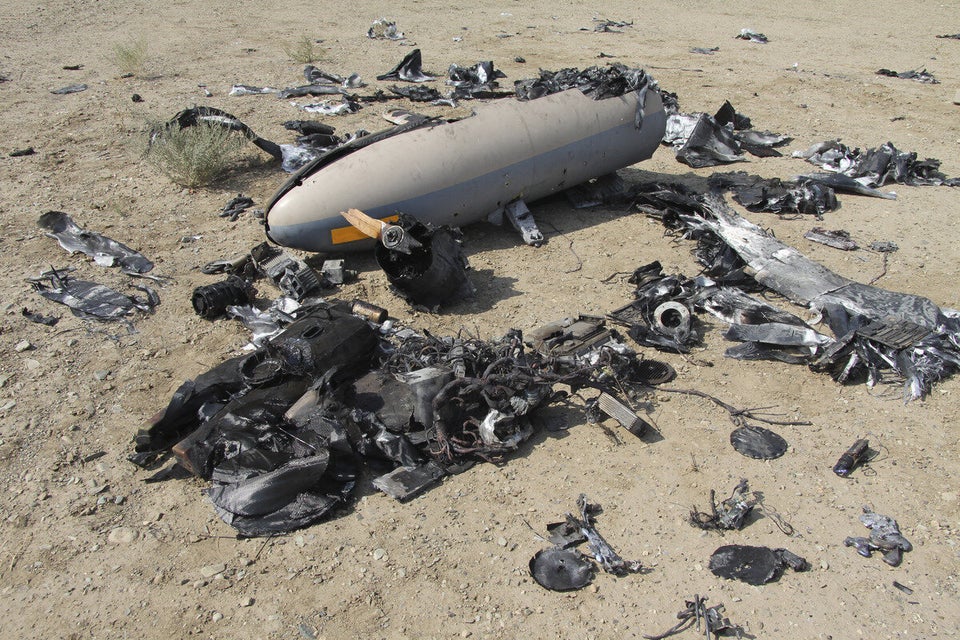Iran's state TV has broadcast footage of what it claims is an Israeli drone shot down over the weekend near an Iranian nuclear site.
Arabic-language Al-Alam TV showed parts of a mechanical object scattered across a desert site, and identified it as a Hermes 450 drone known to be used by the Israeli army. There are no identifying Israeli markings on the drone, however, and the Israeli military has refused to comment.
It was purportedly shot down over the Nantaz enrichment plant. But some experts have cast doubt over the authenticity of the pictures. Israeli journalist Yossi Melman, a former senior correspondent for Haaretz on national security and intelligence said the parts looked similar to drones used in the 1970s, and would not be in use now.
But he was contradicted by another specialist in arms and aerial vehicles, who told Haaretz that the device looks like a kind of unmanned aerial vehicles used by the Israeli military.
The incident comes as Iran negotiates with world powers over its controversial nuclear program and Iranian hard-liners press moderate President Hassan Rouhani to demand more concessions before limiting the country's atomic capabilities. Israel has not ruled out taking military action against Iran's nuclear facilities if its capability to build an atomic weapon progresses.
The West suspects Iran's nuclear program is geared toward building a nuclear weapon. Iran denies the charge, saying its nuclear activities are for peaceful purposes only, such as power generation and medical research.
The Guard statement on Sunday said its forces fired a missile as the drone neared Iran's uranium enrichment facility in Natanz, some 240 kilometers (150 miles) south of the capital, Tehran, without providing more details.
On Monday, Gen. Amir Ali Hajizadeh, head of the Guard's airspace division, insisted that the drone was Israeli, though he said its last flight did not originate in Israel.
Hajizadeh said the drone's range was about 800 kilometers (500 miles) and that it had two front and side cameras capable of providing high-resolution panoramic imaging. Israel is about 1,000 kilometers (620 miles) away from Iran's westernmost boundary and Natanz is about 600 kilometers (370 miles) inland from the closest border point in Iran.
"The operational range of the drone indicates it did not start its flight in Israel but departed from a country in the region," he said, adding cryptically, "We have some clues."
While Israeli officials refused to comment on the Iranian claim, Israel is known to possess a vast collection of sophisticated surveillance aircraft, including the Hermes. However, the aircraft's maker, Elbit, says the Hermes has a range of only 300 kilometers (200 miles), which would put Iran outside of its range.
Israel considers the Iranian nuclear program a grave threat, believing the Iranians are trying to develop a nuclear weapon, and Israeli intelligence closely monitors the program.
The Tehran program has been the target of espionage and sabotage efforts in the past. In 2010, the so-called Stuxnet virus temporarily disrupted operation of thousands of centrifuges, key components in nuclear fuel production, at Natanz.
Iran says it and other computer virus attacks are part of a concerted effort by Israel, the U.S. and their allies to undermine its nuclear program through covert operations. Israel has never commented on the allegations but is widely believed to have been involved in the Stuxnet attack.
Since then, Iran has also said that it discovered tiny timed explosives planted on centrifuges but disabled them before they could go off.
On Monday, Asghar Zarean deputy head of Iran's atomic department, told the semi-official ISNA news agency that some of the malware discovered over the past month had targeted a nuclear facility that went online over the weekend.
He was likely referring to the plant in the central city of Isfahan inaugurated on Saturday. Under an interim nuclear deal with the world powers, the facility will convert a type of uranium into a material that cannot be used to make nuclear weapons.
"It's obvious to us that countries like Germany, France and Britain under leadership of the United States are involved in efforts to disturb our activities," said Zarean.
